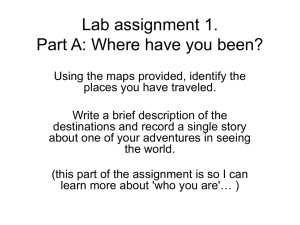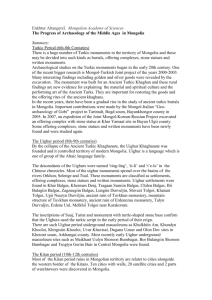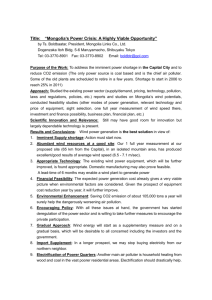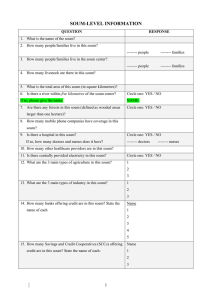GIS BASED LAND INFORMATION SYSTEM FOR MANDAL SOUM, SELENGE AIMAG
advertisement
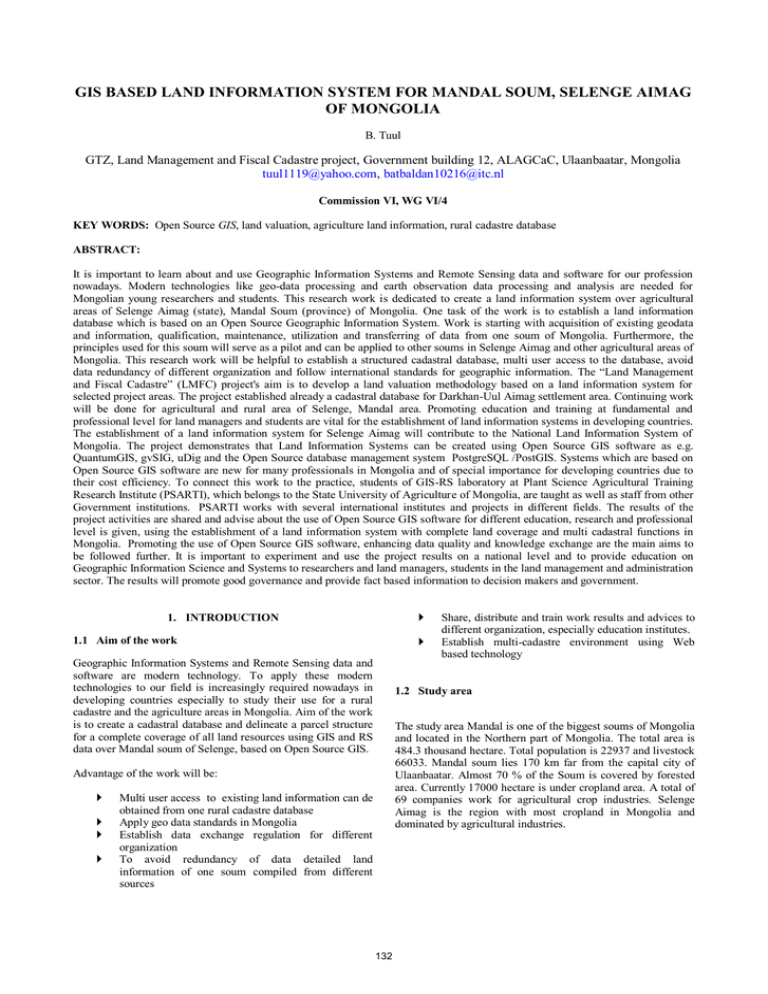
GIS BASED LAND INFORMATION SYSTEM FOR MANDAL SOUM, SELENGE AIMAG OF MONGOLIA B. Tuul GTZ, Land Management and Fiscal Cadastre project, Government building 12, ALAGCaC, Ulaanbaatar, Mongolia tuul1119@yahoo.com, batbaldan10216@itc.nl Commission VI, WG VI/4 KEY WORDS: Open Source GIS, land valuation, agriculture land information, rural cadastre database ABSTRACT: It is important to learn about and use Geographic Information Systems and Remote Sensing data and software for our profession nowadays. Modern technologies like geo-data processing and earth observation data processing and analysis are needed for Mongolian young researchers and students. This research work is dedicated to create a land information system over agricultural areas of Selenge Aimag (state), Mandal Soum (province) of Mongolia. One task of the work is to establish a land information database which is based on an Open Source Geographic Information System. Work is starting with acquisition of existing geodata and information, qualification, maintenance, utilization and transferring of data from one soum of Mongolia. Furthermore, the principles used for this soum will serve as a pilot and can be applied to other soums in Selenge Aimag and other agricultural areas of Mongolia. This research work will be helpful to establish a structured cadastral database, multi user access to the database, avoid data redundancy of different organization and follow international standards for geographic information. The “Land Management and Fiscal Cadastre” (LMFC) project's aim is to develop a land valuation methodology based on a land information system for selected project areas. The project established already a cadastral database for Darkhan-Uul Aimag settlement area. Continuing work will be done for agricultural and rural area of Selenge, Mandal area. Promoting education and training at fundamental and professional level for land managers and students are vital for the establishment of land information systems in developing countries. The establishment of a land information system for Selenge Aimag will contribute to the National Land Information System of Mongolia. The project demonstrates that Land Information Systems can be created using Open Source GIS software as e.g. QuantumGIS, gvSIG, uDig and the Open Source database management system PostgreSQL /PostGIS. Systems which are based on Open Source GIS software are new for many professionals in Mongolia and of special importance for developing countries due to their cost efficiency. To connect this work to the practice, students of GIS-RS laboratory at Plant Science Agricultural Training Research Institute (PSARTI), which belongs to the State University of Agriculture of Mongolia, are taught as well as staff from other Government institutions. PSARTI works with several international institutes and projects in different fields. The results of the project activities are shared and advise about the use of Open Source GIS software for different education, research and professional level is given, using the establishment of a land information system with complete land coverage and multi cadastral functions in Mongolia. Promoting the use of Open Source GIS software, enhancing data quality and knowledge exchange are the main aims to be followed further. It is important to experiment and use the project results on a national level and to provide education on Geographic Information Science and Systems to researchers and land managers, students in the land management and administration sector. The results will promote good governance and provide fact based information to decision makers and government. 1. INTRODUCTION 1.1 Aim of the work Geographic Information Systems and Remote Sensing data and software are modern technology. To apply these modern technologies to our field is increasingly required nowadays in developing countries especially to study their use for a rural cadastre and the agriculture areas in Mongolia. Aim of the work is to create a cadastral database and delineate a parcel structure for a complete coverage of all land resources using GIS and RS data over Mandal soum of Selenge, based on Open Source GIS. 1.2 Study area The study area Mandal is one of the biggest soums of Mongolia and located in the Northern part of Mongolia. The total area is 484.3 thousand hectare. Total population is 22937 and livestock 66033. Mandal soum lies 170 km far from the capital city of Ulaanbaatar. Almost 70 % of the Soum is covered by forested area. Currently 17000 hectare is under cropland area. A total of 69 companies work for agricultural crop industries. Selenge Aimag is the region with most cropland in Mongolia and dominated by agricultural industries. Advantage of the work will be: Share, distribute and train work results and advices to different organization, especially education institutes. Establish multi-cadastre environment using Web based technology Multi user access to existing land information can de obtained from one rural cadastre database Apply geo data standards in Mongolia Establish data exchange regulation for different organization To avoid redundancy of data detailed land information of one soum compiled from different sources 132 Figure 1. The study area location province) the northern part of the central region (Selenge and Darkhan-Uul) and two districts of Ulaanbaatar. Mongolia is on its way to a market-economy. Good governance in land administration in a frame of Geo science will help for our future development and the project work needs to be linked to universities and different organizations in Mongolia of to promote the use of geo data. Existing data from different sources are quality checked and structured in various layers. All required steps and summarised versions are taught to the university students and aimag land officers. This exchange can give to the student’s new knowledge and an overview of existing GIS software solutions, especially Open Source Software and GIS database knowledge. In agricultural areas especially in cropland a functioning market monitoring is not yet installed in Mongolia. But it is of high importance to give to the state information about the market and to correct the initial auctioning and leasing prices to start the development of a land market. The initial prices are currently much lower than the market-prices paid Therefore investigating the present situation of regulation and advice on work on LM is important. . The difference is a loss for the state-budgetand this money could be made available for state investments such as education and social security. The study area in QGIS software overlays Google imagery and existing sources of information. Here Google imagery is overlaid with existing information about the study area in QGIS (projection UTM/WGS84). Figure 2. Data in QGIS 1.4 PSARTI The basic orientation of PSARTI focuses on the release and introduction of new, superior crop varieties and development of progressive technology for crop cultivation, soil fertility recovery and plant protection. The University has trained over 4200 specialists by 19 professional divisions since 1969 and over 250 students have successfully graduated from Natural science Advanced training school. Today over 1300 students for bachelors and 30 students for master's degree courses are involved in our training. The training is carried out full time, part time external and in postal form. Training is provided in the fields as follows: 1.3 LMFC project The Government of Mongolia emphasises widespread ownership of land as well as an empowerment of economic selfreliant regions. The Government has also realised that the establishment of a cadastral system and a title registry are of major importance for economic development and is attempting to administer and secure the tenure rights of owners, possessors and users of land. The German contribution towards the establishment of a National Land Information System is to support the creation of a market orientated, publicly disseminated, independent valuation of immovable properties. The collected data will be an integral part of the development of a mortgage system, it is also paramount for the function of a real estate market, for an efficient land management by government authorities as well as for an impartial and equal raising of ownership taxes and land fees. The project covers advisory services in: capacity building and providing information for users and public the implementation of modern, transparent valuation methods for immovable properties and development and use of the geodatabase law examination and recommendations for amendments to the legal framework advisory services in institutional development Project activities are focused on areas with different types of land use in the eastern part of the west region, (Zavkhan 1. 2. 3. 4. 5. 6. 7. 8. 9. 10. 11. 12. 13. 14. 15. 16. 17. 18. 19. 133 Agronomy master's, bachelor's Agro farming master's, bachelor's Agro chemistry, soil science bachelor's Land management bachelor's master's, bachelor's Land cadastre Ecology, Environmental protection Environmental management Natural tourism (Ecotourism) Chemistry Hydrometer and hydro chemistry Meteorological data processing Hydrological construction engineering Engineer – mechanics Business economy Accounting Production management Marketing management Surface water management Natural Science Advanced Training school collection and registration of agriculture land for valuation purpose. 1.5 Materials and methods Existing materials Figure 4. Used software (QGIS, uDig, PostGIS, LM) and main structure Cadastral mapping and registration for urban and agricultural area by Asian Development Bank funded project which was performed in 2007 in Mongolia. Land Inventory data by ALACGaC in 2005. Soil quality status data from 2005. Soil assessment data from ALAGCaC compiled in 2006. Forest compartment boundaries over the study area 2009. Raster imageries (Aster, Landsat, prepared Google Earth imageries). Zuunkharaa city general plan 2005-2025. Pasture management reports over the study area from 2009. Metadata standards 2009. LMFC Existing reports, materials. 1:25000, 1:100000 scale digital topographical maps over Mandal area. Vector layers including official and non official aimag and soum boundary. High accuracy and latest data difference in QGIS. ADB data (red), LID (blue) Since the data base focuses on Mandal soum The definition of the official aimag and soum boundaries is important for the land information system establishment. First different data sources for soum boundaries with different projections have been analyzed. Figure 5. Difference of measurement in QGIS Figure 3. Different data sources for soum boundaries. Forest compartment layer is overlaid to with land inventory forest data. Figure 6. Forested area in the study area 1.6 Methods Because of its cost effectiveness and since it is easy to use the promotion of Open Source software in education is important in developing countries for professionals’ and students. General base data preparation steps can be done in three different ways for delineation of parcels and for complete coverage information in the Database (DB). Data-ArcGIS/Quality checking-Import to DBComplete Coverage Data-Import to-QGIS/Quality checking-Complete Coverage Data-High/Medium resolution satellite imagery Complete Coverage of Land use One of the important applications is “Land Manager” (LM), which was developed by the LMFC project. It has an Administration, Cadastre, Land fee, Application Registration and Help menu. Aim of the software is to support the registration of land ownership-, possess-, and use right applications and to manage and calculate land fee payments for Open Source Software for the GIS and the database management system was used: Quantum GIS for cadastral maintenance and updating including history, PostgreSQL/PostGIS, uDig for GIS based real market price 134 different land use categories. Existing cropland contract information can be entered with the LM software and can be analysed further for land fee calculation for agricultural land. 2.2 Results for cropland areas Based on existing different source of data the cropland area of Mandal soum was analysed. Some of the brief results and analysis are shown in a graphical order. Collection of input contracts over agricultural areas (cropland) can be managed and registered by the Land-Manager database. It is important to query, especially prices, total area of cropland and total amount payable for each land-use category within one year. Current usage of cropland in Mandal Soum in Figure 9. Figure 9. Current usage analysis from soil quality status data Figure 7. LM software, Administration tab and tree view The Database holds information about the calculated amount of land-fee for cropland in the soum, which may differ from year to year as stated in the contracts. The data was used for an analysis of soil quality information, analysis on real price information and the analysis of market prices for agricultural land of the study area. Some examples for the analysis of already collected data for cropland are shown below. Figure 8. LM "Land Fee" tab with tree view Figure 10. Basic soil indicators for cropland over Mandal 2. RESULTS To completely collect existing geo data for one soum, assess their quality, store it by using Open Source GIS software, and compile agriculture land information was the main aim under this work. The experiences and results have been used for education and training in different levels. Figure 11. Type of cropland in Mandal soum 2.1 Result on Open Source GIS software The use of Open Source Software on educational level and in practice (land offices) will promote knowledge and experience in a digital environment. A total of 15 computers in the GIS and RS laboratory have prepared with Open Source Software for GIS use and students are working with it. Since the beginning of 2010 Land officers in the Darkhan Land Office are using the software for their daily work. Possess rights for cropland in Mandal soum with a duration of 60years. 135 Figure 12. Duration of certificates for possess rights in Mandal soum. Acknowledgements and Appendix (optional) I would like to make acknowledgements of support for the paper especially thanks to Mr Finkemeyer team leader of LMFC project for his kind support on this work. I would like to thank especially Mr. Michael Wagner and Andreas Glaesel, M.A for their support on the paper. Finally, I would like to thank Ms. Altaa and Mr. Togi for their help with preparation and migration of data. I would also like to thank ALACGaC for providing me with data and information. Contractual rights for cropland areas in Mandal soum . cropland areas in Mongolia are mainly under possess rights (15-60 years), a few are covered by use rights applied. Figure 13. Possess and use rights for cropland area 3. CONCLUSION LMFC project aims to modernize the land management sector in Mongolia. New affordable GIS technology is used to improve the administration of land resources. The examples delivered in pilot areas are used for capacity development and trainings in cooperation with Mongolian universities. Follow Up on international geo standards is required in Mongolia. One coordinate reference system for all Geo data Quality check for Geo data and responsibility for different organization and projects who work together Need for data sharing and exchange of ideas and working together towards one aim. Related regulation from Government and decision makers is needed Requires education and training for different specialists and students in this field 136
